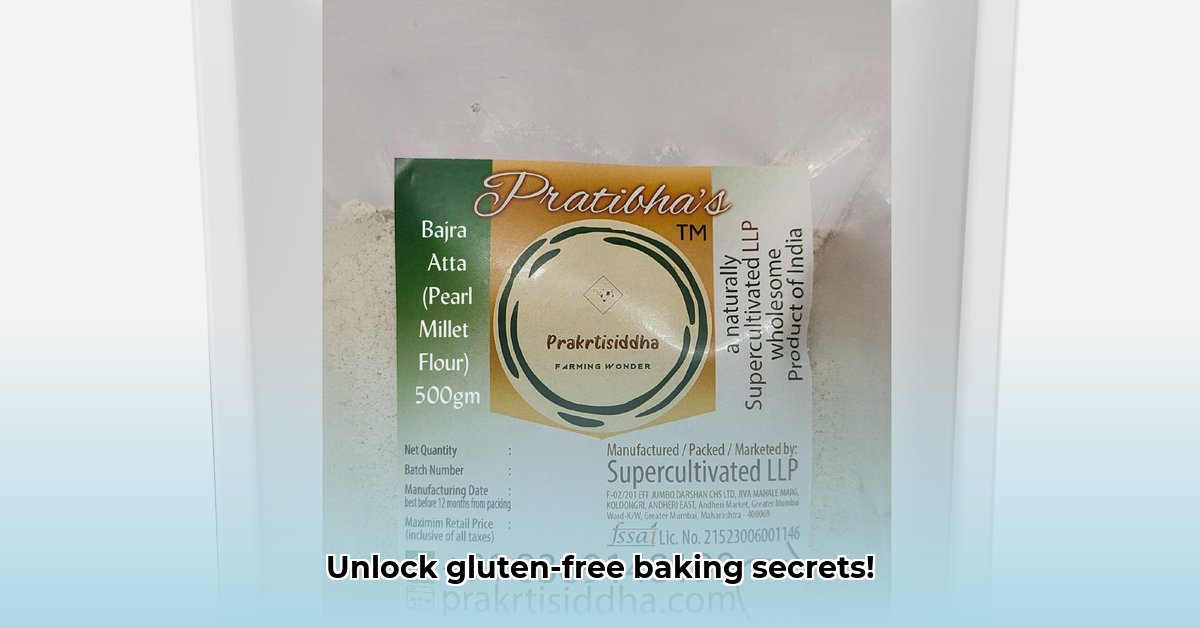Looking for a gluten-free flour that’s actually good? Millet flour might be your new best friend. It’s packed with nutrients, gentle on your gut, and surprisingly versatile in the kitchen. This article will show you everything you need to know about millet flour, from its nutritional powerhouse status to how to bake amazing things with it, plus some handy tips to avoid any baking mishaps. We’ll even explore why it’s a great choice for the planet. So, whether you’re already a gluten-free pro or just starting out, get ready to discover the amazing world of millet flour!
Flour of Millet: A Gluten-Free Baking Powerhouse and Healthy Alternative
Millet flour—it’s a name that might sound unfamiliar, but this little grain packs a powerful nutritional punch making it a favorite among those seeking gluten-free baking options. Let’s explore why it is a true powerhouse.
Nutritional Powerhouse: A Tiny Grain, Big Benefits
Forget what you think you know about gluten-free baking; millet flour is far from bland. It’s a nutritional powerhouse brimming with protein, fiber, and a range of essential vitamins and minerals. We’re talking iron, magnesium, zinc, and various B vitamins – all vital for maintaining good health. Compared to other popular gluten-free options like rice or almond flour, millet flour often boasts a competitive concentration of these key nutrients. Is it the nutrient boost your diet needs?
| Nutrient | Millet Flour (approx. per 100g) | Rice Flour (approx. per 100g) | Almond Flour (approx. per 100g) |
|---|---|---|---|
| Protein (g) | 10-12 | 7-8 | 20-22 |
| Fiber (g) | 4-6 | 1-2 | 10-12 |
| Iron (mg) | 3-5 | 1-2 | 4-6 |
| Magnesium (mg) | 100-150 | 30-50 | 250-300 |
| Zinc (mg) | 2-3 | 0.8-1.2 | 3-4 |
| Potassium (mg) | 250-350 | 80-120 | 600-800 |
Note: These values are estimates and can vary depending on the specific variety of millet and how it’s processed.
Health Benefits: Beyond Gluten-Free
Beyond its gluten-free status, millet flour offers a wealth of potential health benefits. Studies suggest it may help regulate blood sugar levels, making it a potentially valuable addition to the diets of individuals with diabetes or prediabetes. Its high fiber content contributes to digestive health and may also help lower cholesterol levels, supporting cardiovascular health. Furthermore, the prebiotic properties of millet flour are believed to nurture a healthy gut microbiome, which plays a critical role in overall well-being. Some studies highlighted in the Journal of Scientific & Innovative Research indicate millet’s potential for improving gut health by promoting beneficial bacteria. It’s a versatile ingredient with potential benefits for many aspects of your health.
The Challenges: Texture and Antinutrients
While millet flour excels in its nutritional profile, it does present some unique challenges. Its texture tends to be denser and more crumbly compared to wheat flour, which might lead to slightly less airy baked goods. Additionally, like many whole grains, millet contains antinutrients—substances that can potentially interfere with nutrient absorption. However, these are easily addressed. Soaking or sprouting the millet before grinding it into flour can significantly reduce the antinutrient content, enhancing nutrient bioavailability.
Baking with Millet Flour: Tips for Success and Recipes
Don’t be intimidated by the slightly denser texture of millet flour! With a few simple techniques, you can create delicious gluten-free baked goods. Here’s how:
- Blending is Key: Combine millet flour with lighter flours, such as tapioca starch, sweet rice flour, or arrowroot powder. Using a blend creates a better consistency and prevents overly dense results.
- Binding Agents are your Friends: Eggs, xanthan gum, guar gum, psyllium husk, chia seeds, or flax eggs can add structure and improve the overall texture of your baked goods. Experiment to find what works best for your recipe.
- Start Small, Experiment Often: Begin by substituting a small portion (around 25%) of your usual flour with millet flour. Gradually increase the proportion as you become more comfortable with its behavior in your recipes.
- Adjust Liquid Ratios: Millet flour can absorb more liquid than wheat flour. You may need to increase the amount of liquid in your recipe to achieve the desired consistency.
Millet: A Sustainable Choice
Beyond its culinary versatility, millet offers a significant environmental advantage. It’s known for being exceptionally drought-resistant, requiring less water to cultivate compared to many other grains. The Millet Project, supported by the Berkeley Food Institute, highlights millet’s ability to thrive in drought-like conditions, making it a sustainable crop choice, contributing to environmentally friendly food production.
Beyond Baking: Exploring the Culinary Universe of Millet Flour
Millet flour is an incredibly versatile ingredient that extends far beyond baking. Its slightly nutty flavor adds a unique touch to a wide variety of dishes. Consider using it in savory applications like flatbreads, pancakes, or as a thickener for soups and stews. It can also be used as a coating for fried foods, providing a crispy, gluten-free alternative to traditional breadcrumbs.
Ongoing Research and Future Possibilities
Research into the specific health benefits of millet flour is ongoing. While current evidence suggests several positive effects, further studies are needed to fully understand the extent of these effects. Institutions are continuing to explore millet flour’s contributions to a healthy human diet, and more conclusive findings may emerge in the future.
How to Improve Millet Flour Texture for Gluten-Free Baking
Key Takeaways:
- Millet flour offers a nutritious gluten-free option but presents textural challenges.
- Blending with other starches improves texture and rise.
- Binding agents like xanthan gum enhance structure.
- Soaking or sprouting millet before milling improves texture.
- Experimentation is key to finding your perfect millet flour recipe.
Understanding Millet Flour’s Quirks
Millet flour, a treasure from ancient grains, boasts a nutty flavor and impressive nutritional profile. But let’s be honest, it’s not always the easiest flour to work with. Its inherent crumbly nature can lead to dense, heavy baked goods. So, how to improve millet flour texture for gluten-free baking? The answer, as with many things in baking, lies in understanding and adapting.
The Science of Texture Improvement
Millet flour lacks the elastic properties of gluten, the protein network that gives wheat flour its structure. This is why gluten-free baking often requires creativity. We need to mimic that structure. This is where blending and adding binding agents come into play.
Think of it like building a house: millet flour provides some of the bricks, but we need other materials for strength and stability.
Blending for Success
Combining millet flour with other starches, such as tapioca starch, rice flour, or potato starch, significantly improves texture. These starches add lightness and create a fluffier crumb. Experiment with ratios to find what you prefer; a good starting point might be a 50/50 blend.
The Power of Binding Agents
Binding agents are critical for achieving the right consistency. Xanthan gum, guar gum, psyllium husk, or even a flax egg can act as a glue, holding the batter together and creating a more cohesive structure. Start with a small amount (around 1 teaspoon per cup of flour) and adjust based on your recipe.
Pre-Treatment Techniques
Soaking or sprouting millet grains before milling can also enhance texture. Soaking softens the grains, making the flour finer and more absorbent. Sprouting takes this a step further, releasing enzymes that improve digestibility and texture. To sprout millet, soak it in water for 8-12 hours, then drain and rinse it every 12 hours for 2-3 days until small sprouts appear.
Recipe Adaptation
Don’t expect millet flour to behave exactly like wheat flour. Recipes often need adjustments. You might need to increase the liquid slightly, reduce baking time (to avoid dryness), or adapt the leavening agents.
Mastering the Art of Millet Flour Baking
Success with millet flour demands experimentation. Start by substituting small quantities of millet flour into existing gluten-free recipes. Gradually increase the proportion as you gain confidence and refine your technique. Embrace the process. Think of each bake as a step towards mastering the art of millet flour baking. Note down your observations after each attempt, what worked, and what didn’t.
Pros and Cons of Using Millet Flour
| Pros | Cons |
|---|---|
| Gluten-free | Can produce dense baked goods |
| Rich in nutrients (fiber, protein) | Requires careful blending and adjustments |
| Nutty flavor | Potential goitrogenic effects (consume in moderation) |
| Relatively sustainable crop | Availability may be limited in some areas |
- Your Perfect Bento Box Bag For Fresh And Tidy Meals - December 2, 2025
- Korean Meal Prep Made Easy For Delicious Weekday Meals - December 1, 2025
- Korean Food Meal Prep Makes Flavorful Weekday Meals Simple - November 30, 2025










